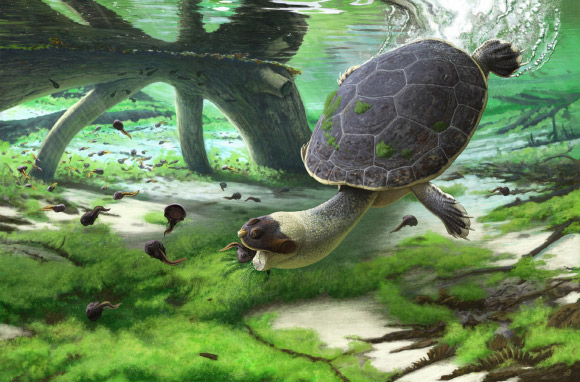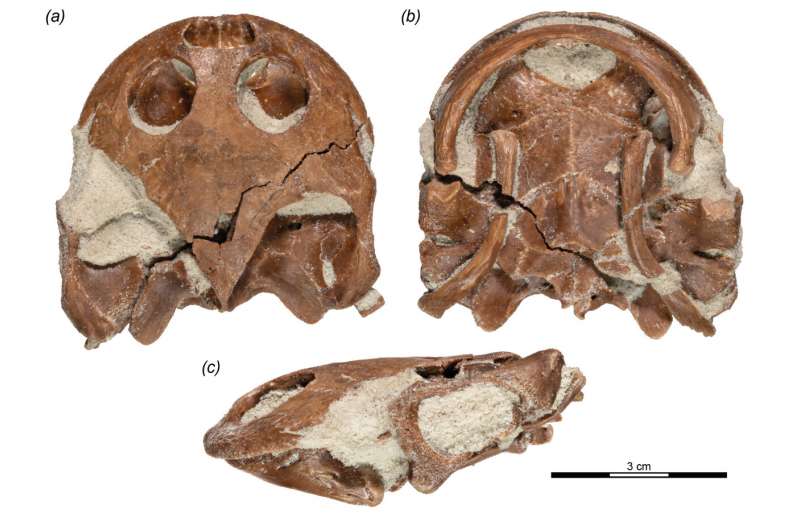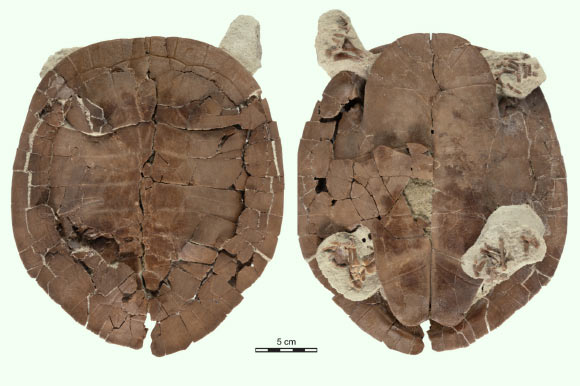
Palaeontologists say discovery of new pelomedusoid turtle from Madagascar’s Late Cretaceous provides evidence for convergent evolution of suction feeding among pleurodires.
Cretaceous turtle with a frog face sucked down its prey
A team of researchers from Universität Freiburg, the Denver Museum of Nature & Science, Université d’Antananarivo and Stony Brook University recently discovered an exceptionally well-preserved fossil of a new and extinct species of pelomedusoid turtle, dating back to the late Cretaceous Period, which began around 100 million years ago and ended some 66 million years ago. The newly identified species (Sahonachelys mailakavava), had an unusually flattened skull, a particularly gracile lower jaw, and enlarged tongue bone, which not only gave it a frog-like appearance, but also suggest that it was a specialised, aquatic suction feeder that fed upon moving prey.

new turtle has several modifications in its skull making it well suited for suction feeding
The team described a new species of pelomedusoid turtle from a geological formation in Madagascar otherwise known for its exquisitely preserved fossil birds, dinosaurs, crocodilians, and mammals.
The new turtle possesses an unusually flattened skull combined with a particularly gracile lower jaw and enlarged tongue bones (hyoids), which not only gave it a frog-like appearance, but also suggests that it was adapted to a specialised feeding mode called suction-feeding. Suction feeders open their mouths rapidly to suck in prey items under water, which is in contrast to other subaquatic feeding modes in which animals shoot their heads forward to reach for prey.
The new turtle has several modifications in its head skeleton that show that it was well suited for suction feeding: its skull is low but wide, and the jaws are strongly bowed and angled forward, which creates a strongly rounded mouth opening that is physically beneficial for creating large suction forces.
The tongue bones are strongly developed, and this hints at large muscles that pulled the tongue skeleton backwards and opened the esophagus during the strike at prey – again creating more suction.
As in all modern turtles, the new species lacks teeth, but in addition the surfaces at the upper and lower jaws that face toward each other are poorly developed, showing that this turtle did not use its jaws to process food, but instead swallowed prey whole, which is typical for suction feeders.
Source: RoyalSocietyPublishing.org

“quick-mouthed frog turtle” was an early relative of podocnemidid turtles
The researchers hypothesise that the turtle fed on small-bodied living prey, such as insect larvae, fish fry, and tadpoles using quick strikes. They, therefore, named the new species Sahonachelys mailakavava, which means "quick-mouthed frog turtle" using Malagasy and Greek words.
Special about the turtle is also its preservation: it is known from a nearly complete skeleton, despite its small body size, barely more than a foot long.
Turtle fossils often come either as shells or skulls that have been separated from one another; for many extinct turtles, researchers only have either one or the other, but not both. Having a complete skeleton helps them to understand the whole animal, and also makes it possible to compare it to other turtle fossils, regardless of how these are preserved.
Based on such comparisons, the team constructed a family tree of turtles that shows that Sahonachelys mailakvava was an early relative of podocnemidid turtles, which today are native to Madagascar and South America, but which were more widespread in the past.
The palaeontological fauna of Madagascar is known for animals that are very specialised, which is in part due to its long isolation from surrounding continents. This fossilised turtle shows that the Madagascan fauna was already unique in the Late Cretaceous: Sahonachelys mailakavava is the only representative of its group to have evolved suction-feeding, which is otherwise only known in distant relatives, so-called snake-necked turtles.
Source: RoyalSocietyPublishing.org

Quotes by the authors:
"This is the best-preserved turtle of the entire Late Cretaceous of the southern continents and as such very significant in terms of reconstructing its way of life and relationships with other turtles"
— Prof. Walter Joyce, first author of study.
"As palaeontologists, we try to understand the biology and evolution of past life. Fossils like this give a wealth of information that is not always present. The identification of suction feeding in a new turtle lineage is exciting and was unexpected. It shows how animals evolve similar traits for similar functions, even if they are only distantly related."
— Serjoscha Evers, co-author of study.
"Sahonachelys is a stunning example of evolution in isolation. It represents a lineage that evolved on Madagascar for over 20 million years and joins a litany of other bizarre Late Cretaceous vertebrate animals that we’ve found on the island. This specimen is, by far, the best turtle fossil we discovered during the 28 years of conducting field research there."
—David Krause, co-author of study)
Source: RoyalSocietyPublishing.org
WHAT CAN YOU DO TO SAVE SEA TURTLES?
Learn what actions you can take to help save sea turtles. — NOAA Fisheries